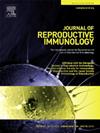Measurement of four novel endometrial NK cell subsets by multiplex staining in women with reproductive failure: A comparison with fertile controls
IF 2.9
3区 医学
Q3 IMMUNOLOGY
引用次数: 0
Abstract
Accumulating evidence indicates a significant increase in CD56 + endometrial NK cells in women with reproductive failure. However, CD56 alone inadequately captures the phenotypic and functional heterogeneity of these cells. This study aims to compare the density of various endometrial NK subsets between women with reproductive failure and healthy controls, as well as evaluate their diagnostic performance. This study included three groups: recurrent miscarriage (RM), repeated implantation failure (RIF), and controls, with 56 women in each group. Endometrial biopsy was performed precisely 7 days after LH surge or five days after the initiation of progesterone. Multiplex immunohistochemistry staining was employed to identify total CD56 +NK cells, classical NK subsets (CD56 +CD16 + and CD56 +CD16-), and four novel NK subsets: NK1-NK4. Using classical markers of NK cells, the density of CD56 +NK cells, as well as CD56 +CD16 + and CD56 +CD16- NK subsets, was significantly higher in women with RM or RIF compared to controls. When NK cells were further categorized into 4 subsets, only the immune-active NK2 and cytotoxic NK4 subsets showed a significant increase in women with RM or RIF groups. No significant differences were observed in the densities of NK1 and NK3. CD56 +CD16 + NK cells, NK2 and NK4 subsets demonstrated higher diagnostic accuracy over total CD56 + NK cells, as indicated by ROC analysis. In summary, this study reveals the specific differences in endometrial NK cell subsets in women with reproductive failure, suggesting that the elevated density of certain NK subsets in the endometrium is associated with an inflammatory microenvironment in women with reproductive failure.
求助全文
约1分钟内获得全文
求助全文
来源期刊
CiteScore
6.30
自引率
5.90%
发文量
162
审稿时长
10.6 weeks
期刊介绍:
Affiliated with the European Society of Reproductive Immunology and with the International Society for Immunology of Reproduction
The aim of the Journal of Reproductive Immunology is to provide the critical forum for the dissemination of results from high quality research in all aspects of experimental, animal and clinical reproductive immunobiology.
This encompasses normal and pathological processes of:
* Male and Female Reproductive Tracts
* Gametogenesis and Embryogenesis
* Implantation and Placental Development
* Gestation and Parturition
* Mammary Gland and Lactation.

 求助内容:
求助内容: 应助结果提醒方式:
应助结果提醒方式:


